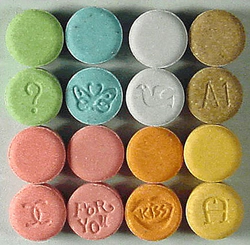Current Trends In MDMA Usage
MDMA usage trends have shifted over time, presenting public health officials and family members with new challenges in combatting the problem.

While it is critical to understand the facts about each drug experimented with in America, it’s also valuable to monitor usage trends and statistics surrounding various mind-altering substances. Staying apprised of ever-changing drug trends will assist concerned individuals in their efforts to help their loved ones get off drugs.
In the case of MDMA, usage trends and statistics have shifted over time, presenting public health officials and family members with new challenges in combatting the problem.

Courtesy of Teens.Drugabuse.gov
Defining MDMA
MDMA, also called ecstasy or molly, is a stimulant, psychedelic drug that produces an energizing effect on the user. The drug causes distortions in perception and time and enhances the enjoyment of tactile experiences. MDMA can produce euphoria in users while reducing inhibitions and inspiring feelings of closeness, empathy, and sexuality. Common street names for MDMA include Clarity, Disco Biscuit, Adam, Beans, Hug Drug, Lover’s Speed, Molly, E, Ecstasy, Eve, Go, Peace, STP, X, and XTC.
MDMA Usage Trends by Age
According to the National Institute on Drug Abuse, among Americans age 12 and older, about 0.9% report using MDMA at least once per year. That may not seem like a high usage rate, yet that percentage still accounts for some 2.6 million people. Alarmingly, about 0.6% of 8th graders, 0.7% of 10th graders, and 1.1% of 12th graders use MDMA at least once per year. Those usage rates suggest MDMA is a more common drug of choice among youths (since other street drugs such as opioids, meth, or cocaine have lower percentage rates of use among high school-age individuals).1
According to another source, MDMA usage soared among college-age adults in the 1990s and early-2000s. While usage trends reduced somewhat during the late-2000s and the 2010s, rates of use never fell to the pre-1990s level. Today, about 4% to 5% of college-age adults use MDMA at least once per year.2
MDMA Statistics, Overdoses, and Other Harmful Effects on Record

While MDMA is not associated with high overdose rates like some drugs are, MDMA is still quite dangerous. People who use this drug may experience severe dehydration. In high doses, MDMA can interfere with the body’s ability to regulate temperature, leading to a sharp increase in body temperature. Combined with dehydration, this can lead to liver, kidney, and cardiovascular failure, all of which can be fatal.
According to one research paper, MDMA-related emergency department visits have increased over the years, with fewer than 1,000 such visits in 1995 and more than 22,000 visits in 2011. Further, while each year in the 1990s only saw between 10 and 20 MDMA-related deaths, the 2000s and 2010s witnessed a spike in such deaths, with 30 to 60 people dying from MDMA-related causes each year.
Finally, a growing trend of MDMA users is to consume multiple drugs simultaneously. This activity is an increasingly popular trend called polydrug use. Common substances that are experimented with alongside MDMA are GHB, Ketamine, PCP, benzodiazepines, cannabis, opiates, cocaine, alcohol, amphetamine, and methamphetamine.
MDMA Trends Over Time
As mentioned earlier, a rising concern with MDMA is that users who consume this drug may be consuming more than just MDMA. MDMA is usually distributed in tablet form, so users cannot possibly know what chemicals are pressed into the tablets they buy.
To that point, the Drug Enforcement Administration is increasingly seizing stashes of MDMA that also contain methamphetamine, ketamine, cathinones, and caffeine. There is also a growing risk that fentanyl, the highly-potent synthetic opioid, may be mixed into a supply of MDMA without users knowing.3
Even when other drugs are not mixed into MDMA batches, MDMA is still quite harmful. Repeated use can lead to learning problems and memory loss. Even after just one instance of MDMA experimentation, users can undergo a range of harmful side effects such as confusion, anxiety, depression, paranoia, muscle tension, uncontrollable tremors, involuntary teeth clenching, painful muscle cramps, nausea, faintness, chills, sweating, blurred vision, sleep problems, and cravings.

Further research has shown a concerning connection between MDMA intoxication and homicide, both accidental and intentional. A paper published in 2022 examined 20 years of MDMA-related deaths in the San Francisco area. While the first decade examined by the researchers (2000 to 2010) showed a strong connection between MDMA-related deaths and parties, raves, music festivals, and nightclub scenes, the second decade examined (2011-2020) indicated MDMA-related deaths also included homicides and accidents unrelated to rave or nightclub environments. The data suggest MDMA experimentation is expanding outwards into other demographics and socioeconomic groups, implying that the drug is becoming popular among a wider range of users.4
Except for a few spikes in usage, MDMA experimentation has maintained a slow but steady increase since the 1990s. MDMA deaths, while still low in number compared to other drugs, have increased in the last two decades. Finally, the rising trend of mixing other drugs into MDMA (with or without users knowing about it) poses an additional risk and is likely the explanation for a spike in deaths.
There is no doubt that MDMA experimentation is dangerous to the user and those around them. Family members and loved ones of MDMA users should recognize the increasing risk factors and take action to protect their loved ones through the help of qualified drug rehab centers.
Sources:
-
NIDA. “What is the scope of MDMA use in the United States?” NIDA, 2021. nida.nih.gov ↩︎
-
The DEA. “Usage, Death, and other MDMA Statistics.” The DEA, 2016. thedea.org ↩︎
-
Analytical Toxicology. “Two Decades of Ecstasy: Shifting Demographic Trends in Decedents Using MDMA.” Analytical Toxicology, 2020. academic.oup.com ↩︎






 ®
®